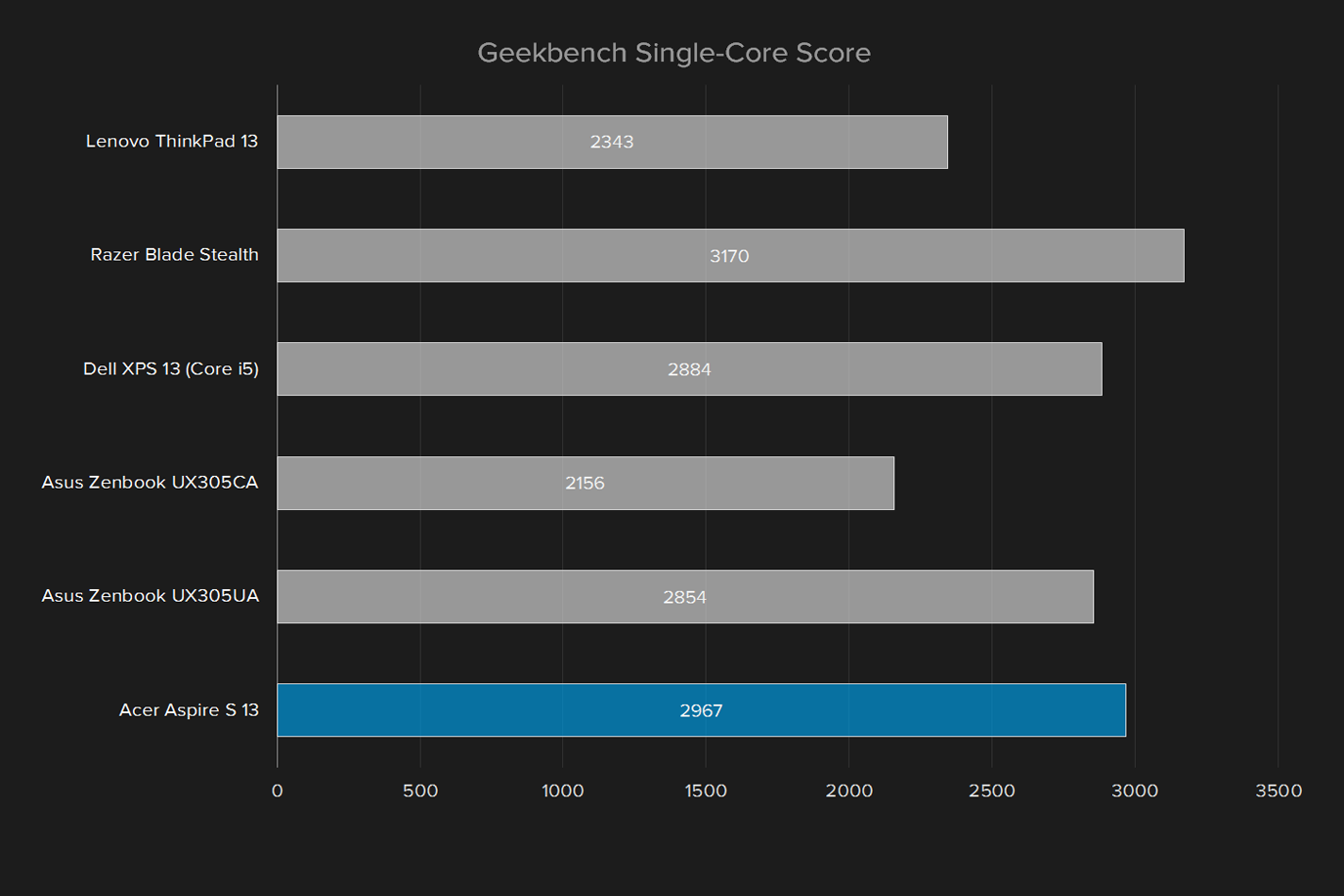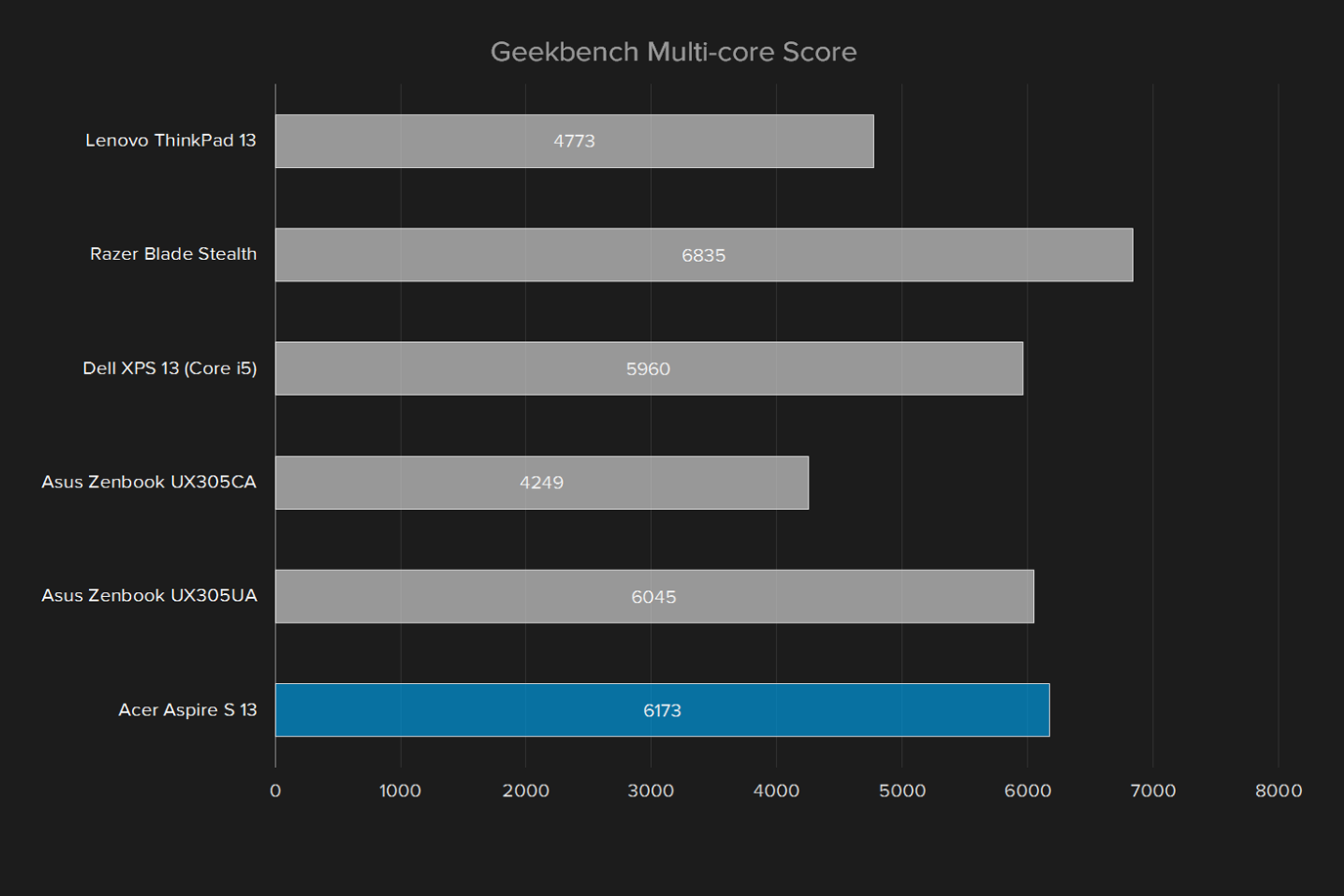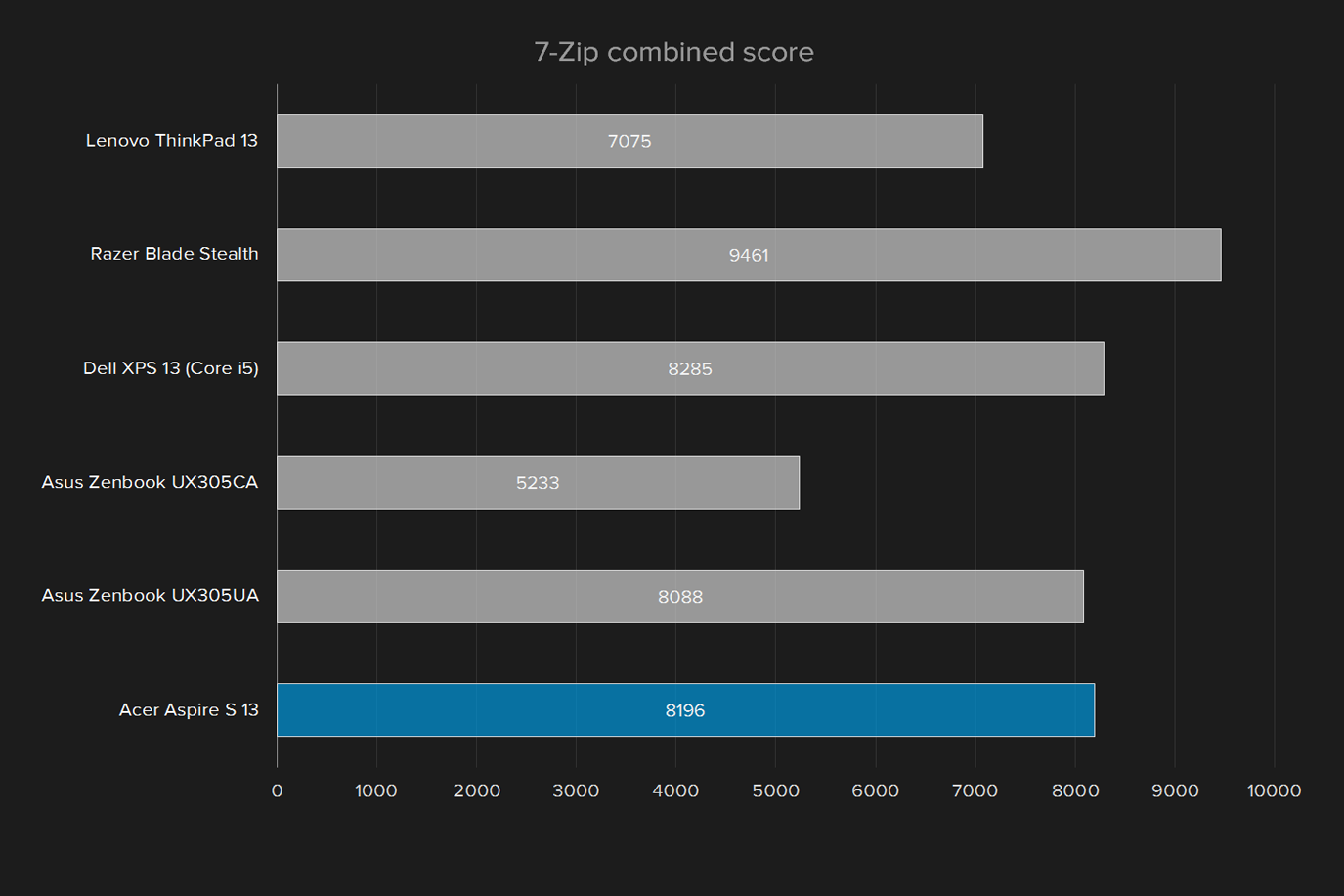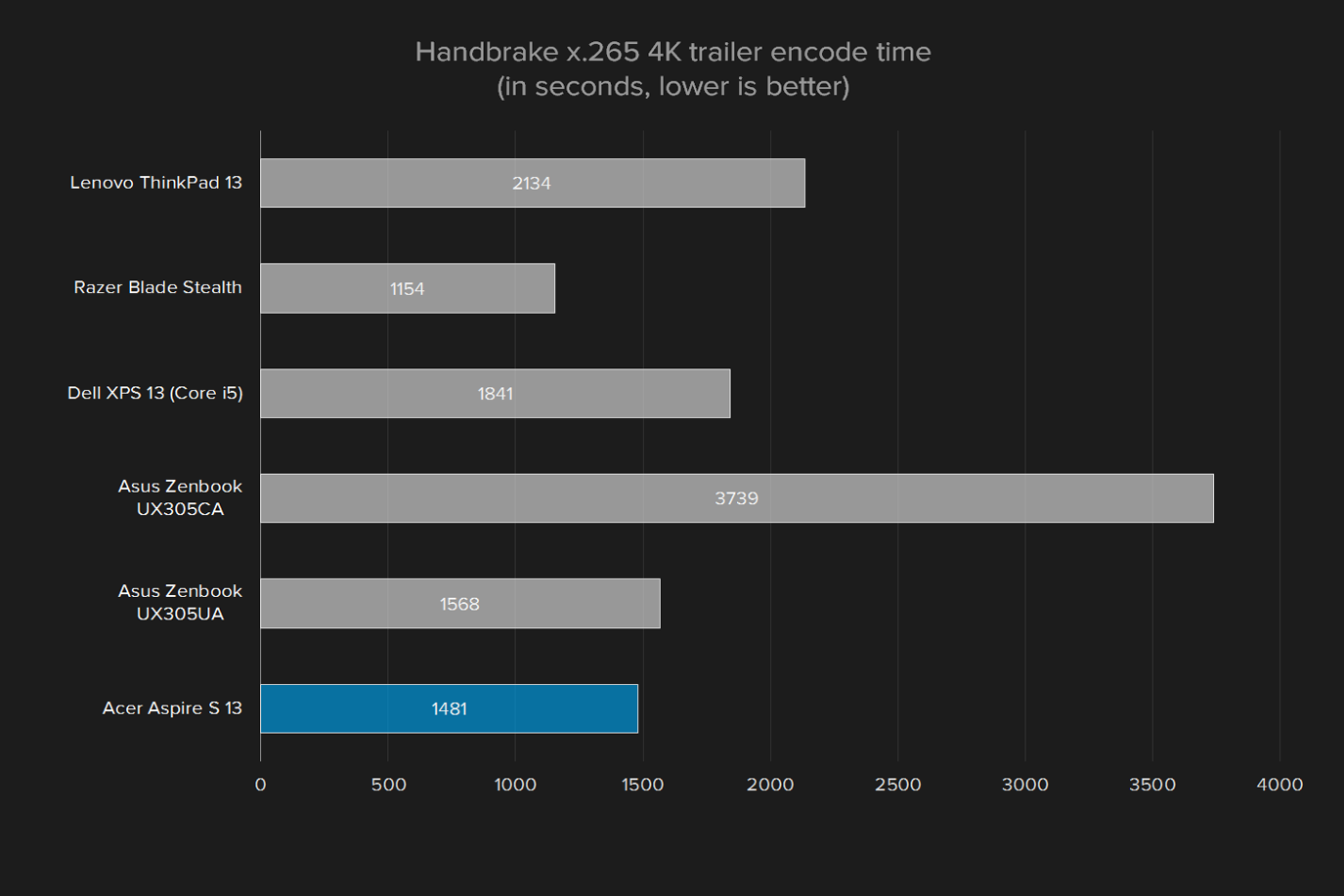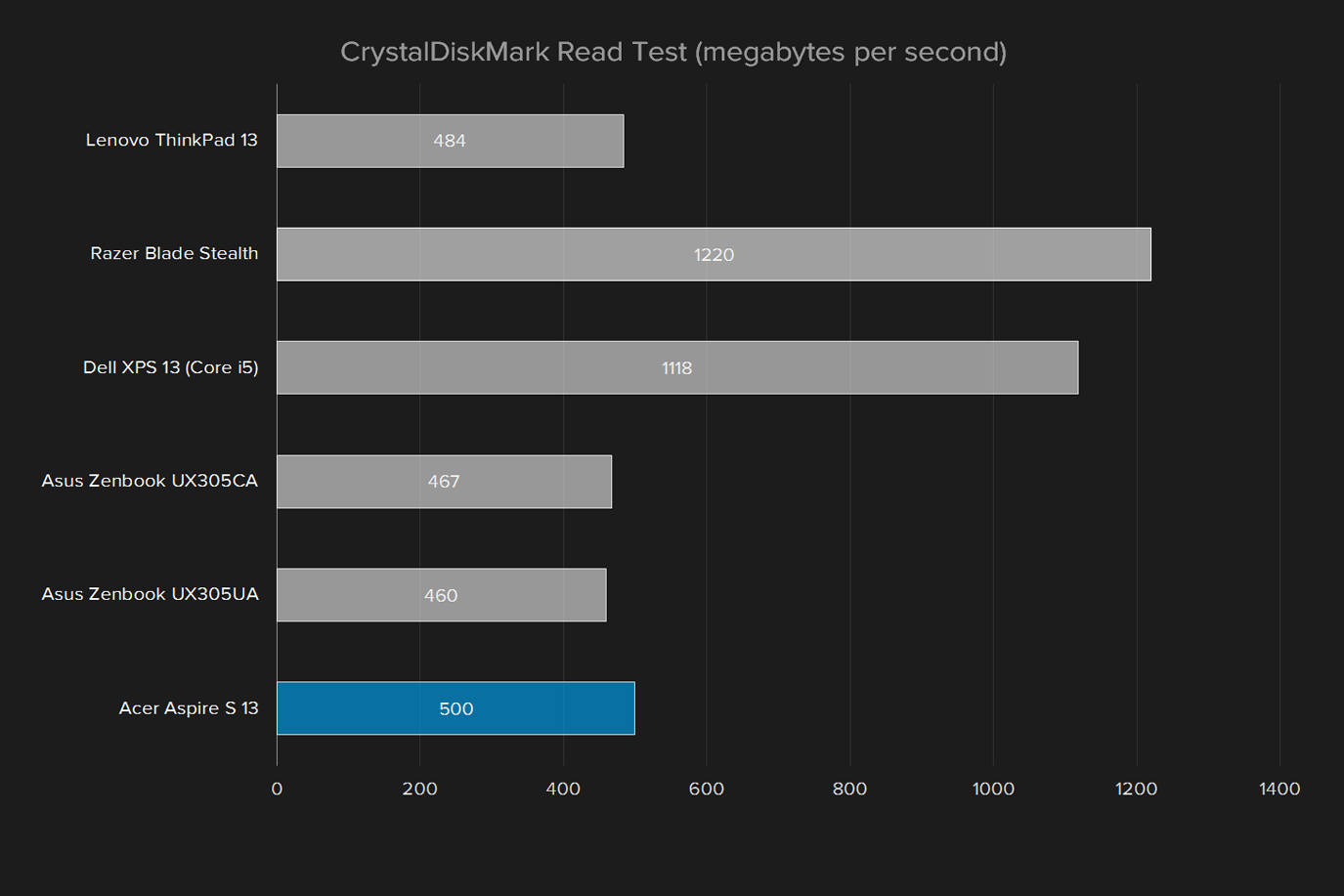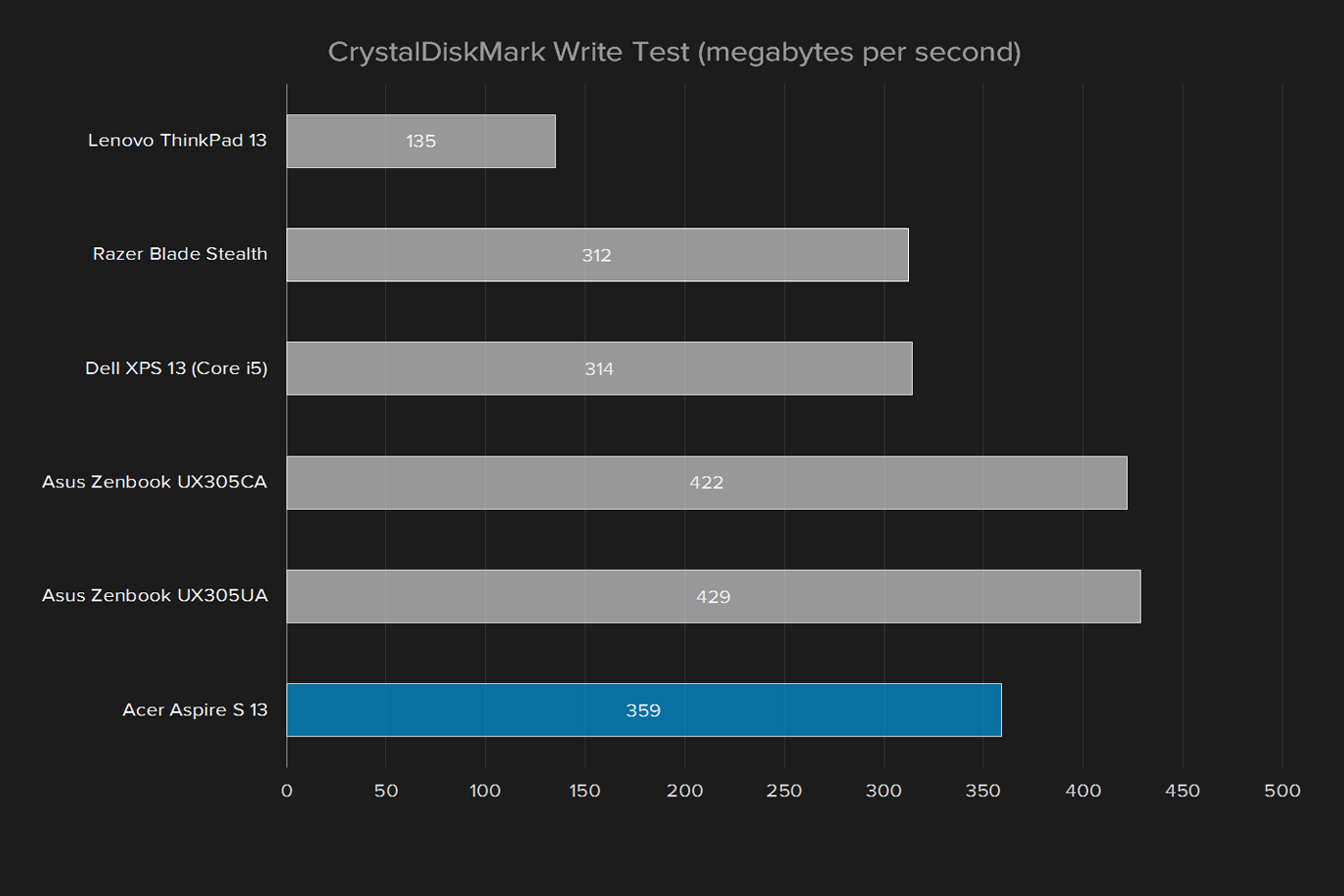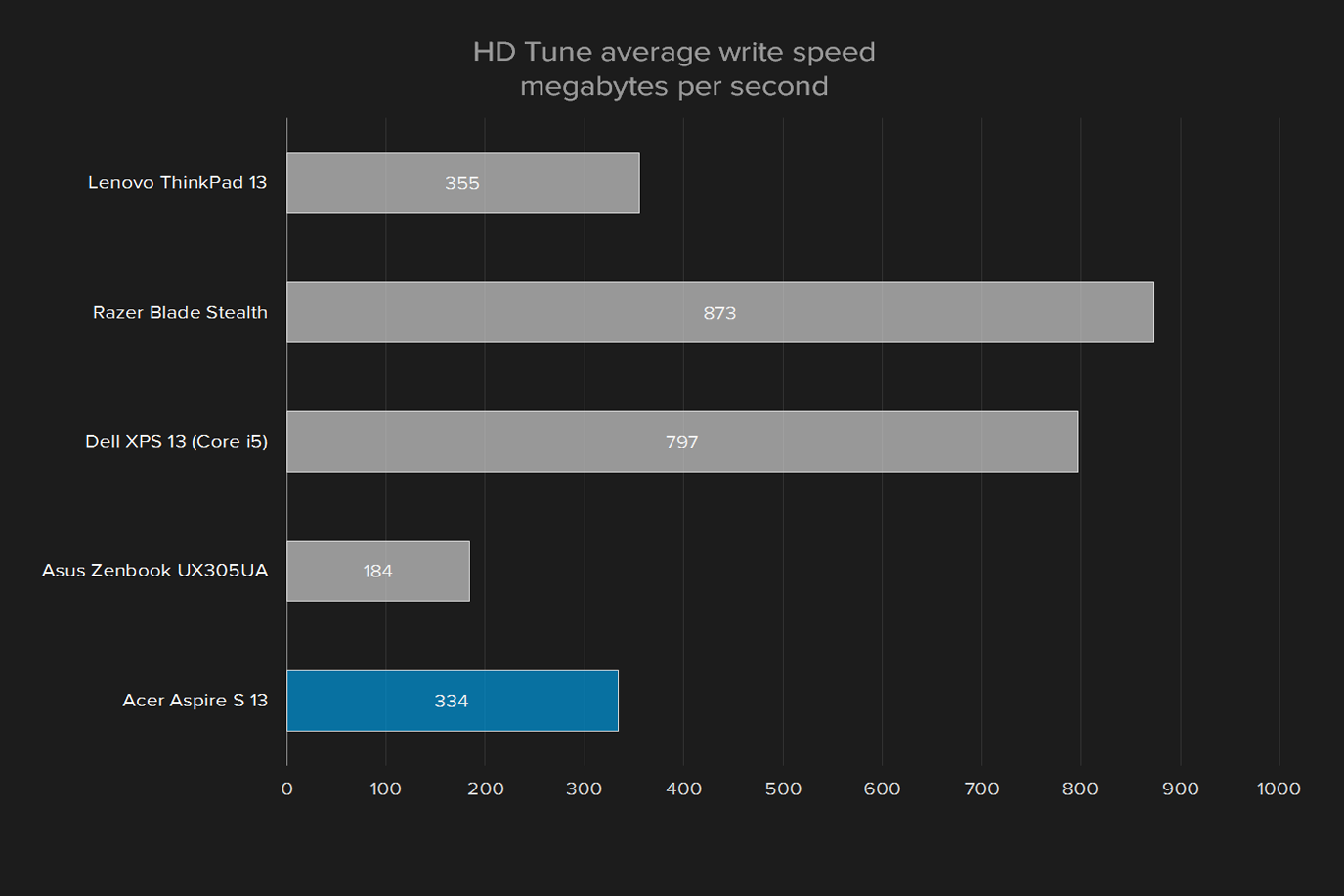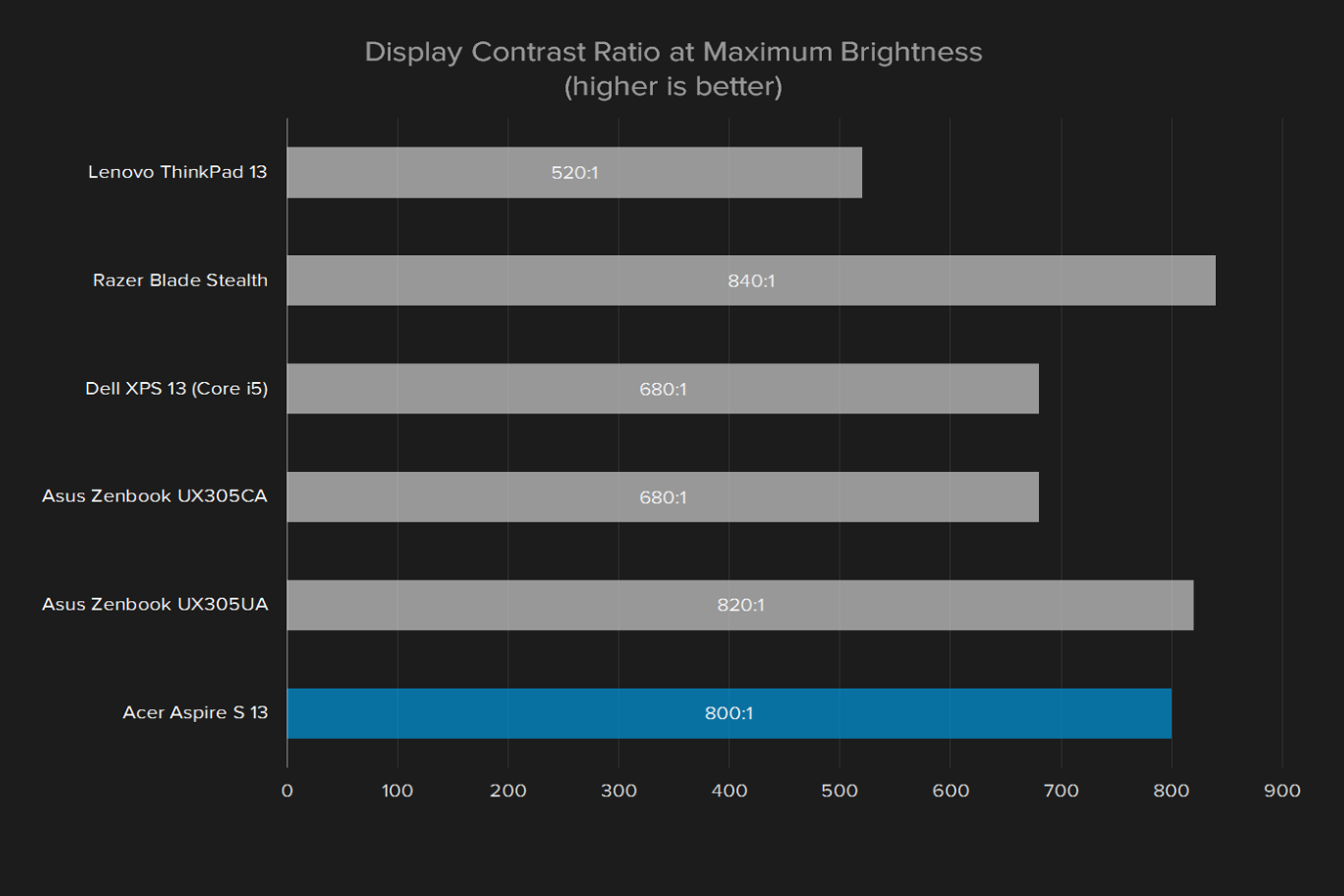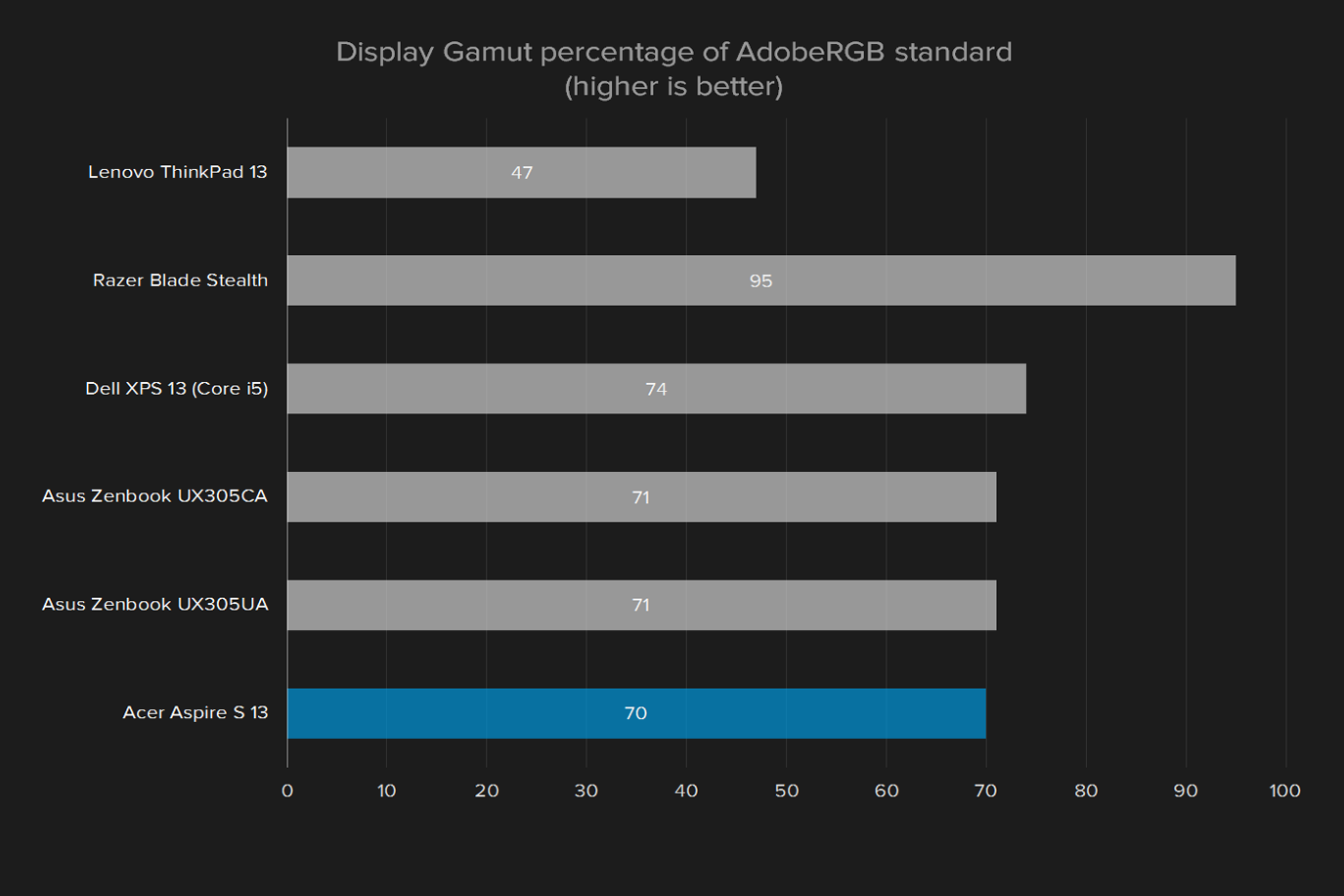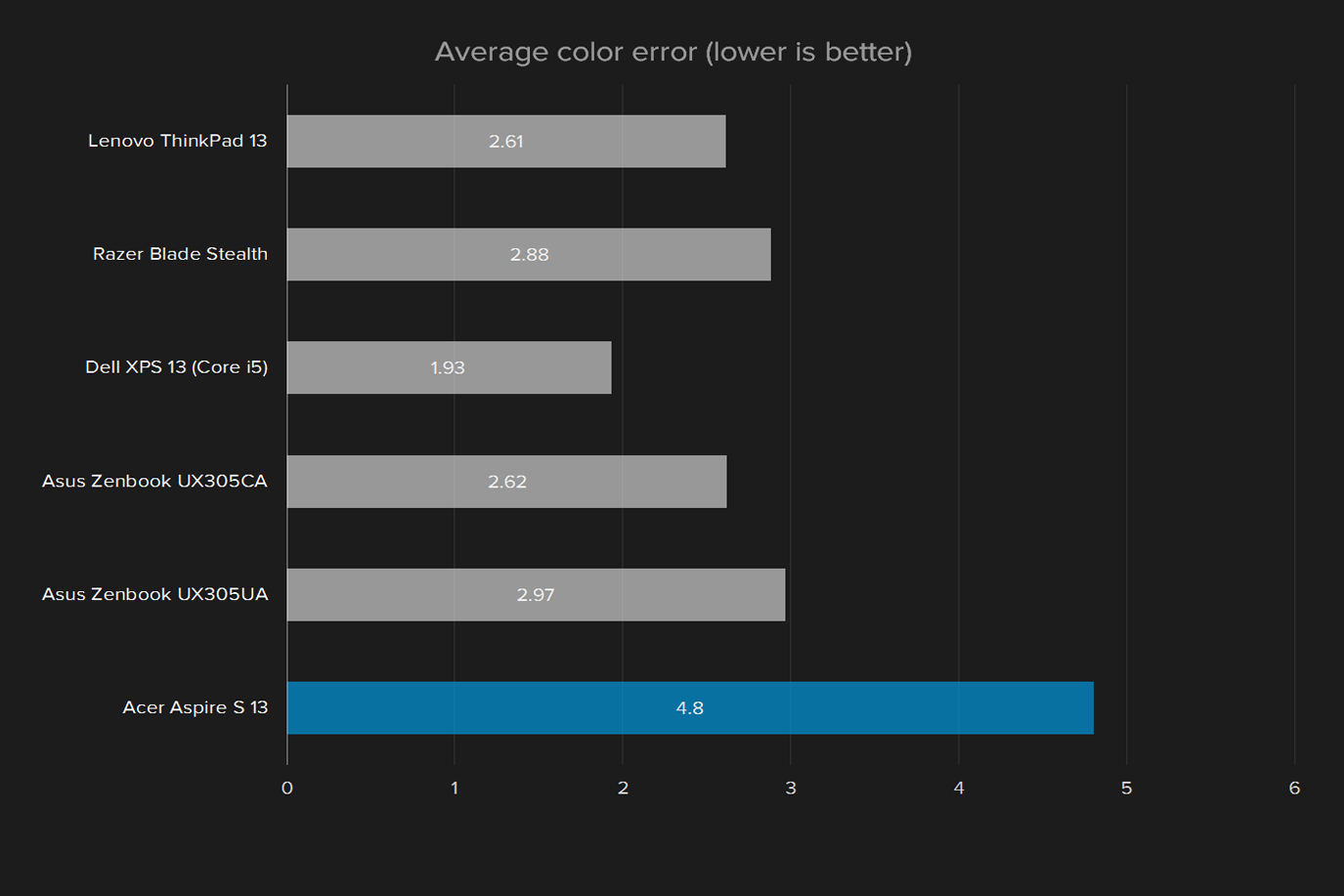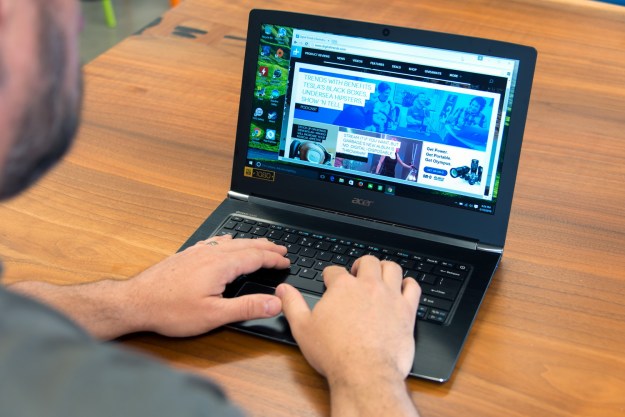
“The Acer Aspire S 13 is a well-rounded laptop that falls just short of the very best.”
- Thin and light
- Has USB 3.1 Type-C connectivity
- High-contrast, matte display
- Strong performance
- Good value
- Disappointing build quality
- Poor display color accuracy
- Mediocre battery life
Acer has never cracked the formula for a great ultrabook. It’s tried – the company’s Aspire S7 series was among the thinnest and lightest around. But its efforts often suffered mediocre design and meager battery life, failings that put Acer behind the very best.
Today’s ultrabook arena is even more competitive. Juggernauts like the stylish Dell XPS 13, aging MacBook Air, and miserly Asus Zenbook UX305UA have grabbed the spotlight. These popular choices quick, portable, and great to use, yet can be had be purchased for less than $1,000.
Acer’s new Aspire S 13 tackles these entries head-on. It has a Core i5 dual-core processor, 8GB of RAM, a 256GB solid state drive, and a 1080p display – all for the affordable price of $750. If that sounds familiar, it’s because both the specifications and price are identical to Asus Zenbook UX305UA, which won our editor’s choice award.
The Asus caught our attention because of its value, but we fell in love with its build quality and design. Can the Acer also reel us in or is it, like past Aspire ultrabooks, a bit chintzy?
Serious business
In 2014 Acer introduced the Aspire V15 Nitro Edition, a 15-inch laptop that combined cutting-edge technology (like a
That design has trickled over to other Acer products, and the S 13 is the latest recipient. The lower half of the chassis is built from black brushed aluminum metal, while the upper half is made of matte black plastic. A grooved design similar to a leather-bound notebook adorns the display lid. The hinge, meanwhile, is painted dark silver and subtly engraved with the words “Aspire S.”
There’s nothing wrong with subdued design, but something has been lost in translating the V15 Nitro Edition’s look to the smaller S 13. Size may, in fact, be the problem. Likes it big brother, the S 13 tries to look macho. This is a very small, thin system, and the bluster comes off as misguided.
Build quality is the real problem. The use of a plastic matte display lid and black aluminum lower half creates a jarring difference, as if each piece was meant for a separate laptop. Worse, the display suffers large bezel gaps, and the bezels don‘t feel secured. We managed to pry a portion open using only a fingernail. That’s bad, no matter the price.
Modern ports
Acer ships the S 13 with two USB 3.0 ports, one USB 3.1 Type-C, HDMI-out, a combo microphone/headphone jack, and an SDcard reader. The Type-C port is the standout. Dell’s XPS 13 offers Thunderbolt 3, but the Asus Zenbook UX305 series offers neither Type-C or
Inputs
Unlike some of its peers, the Aspire S 13 doesn’t do much to thin its display bezels. That means there’s plenty of room inside for a spacious, full-sized keyboard, and Acer has taken full advantage of that. Key caps are large, yet spacing between keys is distinctive. It’s great for quick typists. Key feel is less distinctive. Each stroke feels a bit shallow, which dampens the tactile satisfaction of mashing through keys.
Key backlighting comes standard. There’s just two brightness levels, of which the dimmer is preferable when the system is used in a dark room. Light leak is a noticeable problem depending on the angle the keyboard is viewed from. For us, a normal typing position gave us a sneak peek at the LEDs underneath the function row keys.
The touchpad is, well, a touchpad. It’s about the same size as any other, looks like any other, and feels like any other. Nothing about it stands out, but it doesn’t have any notable flaws. Whether you like it, or not, will depend on how you feel about Windows touchpads in general.
Display
Acer ships every S 13 with a 1080p matte panel. Suddenly, matte feels like a trend; Asus and Lenovo offer several 13-inchers with matte as either an option, or standard, and three makes a crowd. While 1080p doesn’t stand out in today’s post-Retina world, it translates to a respectable 165 pixels per inch. That’s roughly equivalent to a 27-inch monitor with a
Our benchmarks found favorable results. The maximum contrast ratio was 800:1, better than the Dell XPS 13, Asus Zenbook UX305CA, or Lenovo ThinkPad 13. The color gamut spans 94 percent of sRGB, which is average. Maximum brightness hit supernova-like 323 lux. That’s massive for a matte screen, which dampens glare to begin with. We rarely had to turn the S 13’s brightness beyond half its maximum.
Those traits are wins, but the display had flaws. Color accuracy came in at an average error of 4.8, with large errors across all measured colors. Most competitors have an average error around 2 (lower is better in this test). While that may sound small, consider that 4.8 is double the error of most competitors. Gamma wasn’t great, measuring in at 2.4, off the target reading of 2.2.
Acer does deserve credit for strong performance at the S 13’s affordable price.
These numbers can be hard to understand, but the visual problems they cause can be appreciated by anyone. The Aspire S 13’s screen looks too cool and clinical, due to its sizable color inaccuracies, which are most significant in blue and cyan. This is extremely noticeable in bright scenes, where expanses of white or off-white glow blue. The gamma problem also means content is overly dark, which tends to obscure detail in dark scenes. That can dampen the sharp resolution by obscuring fine lines, creases, and shadows that should be visible.
On balance, the S 13’s display is about average. It’s a workmanlike effort, functional and easy to read in variety of situations, but never breathtaking.
A typical sound stage
Like most of its kind, the Aspire S 13 has a pair of front-facing speakers mounted on the lower lip of the chassis. This position makes for decent clarity and volume on an even, hard surface, but can muffle the audio when the laptop is used on a softer platform (like, say, your lap). The laptop produces a respectable maximum volume, but there’s no hint of bass. External speakers or
Processor performance
There are several models of S 13 available, with processors ranging from a Core i3 to i7. Our specific model, the S5-371-52JR, came with a Core i5-6200U processor. This is arguably the most popular Core mobile processor sold today; and it’s certainly the one we most frequently see in review units.
We didn’t expect any surprises, and we saw none. The Aspire S 13’s GeekBench multi-core score of 6,173 trends a bit high for the category, but only by a few percentage points. That’s not the kind of difference users can feel.
Acer does deserve credit for such a strong showing at the price point, however. The Asus Zenbook UX305UA is the only system we’ve tested to deliver similar value. The Lenovo ThinkPad 13 is a bit less expensive, but much slower. Dell’s XPS 13 with a Core i5 processor is just as quick, but you’ll have to spend at least $1,000 to snag one.
Hard drive performance
Acer equipped our S 13 review unit with a 256GB Lite-on CV1 solid state drive. Though not a household name, Lite-on is one of the world’s largest SSD manufacturers. It doesn’t make many drives sold direct to consumers, but its drives are the second most common in
The drive turned in modest, but well-balanced results. Its CrystalDiskMark sequential read speed of 500 megabytes per second is respectable for an inexpensive SSD, and its write speed of 359MBps isn’t bad, either. These scores essentially tie the Asus Zenbook UX305CA and UX305UA.
Build quality is the real problem.
The Razer Blade Stealth and Dell XPS 13 blow away the Aspire S 13 in read tests, but about equal in write tests. Those systems were reviewed with a Samsung 950 Series solid state drive. Read speeds are more frequently noticed by users than writes, since opening a file or program is a “read” action, so the better performance in those competitors is significant. All the drives have access times that measure less than a tenth of a millisecond, however, so you’ll only notice the difference when loading large files and programs.
Graphics performance
The Aspire S 13’s Core i5-6200U comes with Intel HD Graphics 520, the company’s most common integrated graphics solution. This laptop has no serious gaming aspirations, which is good, because it doesn’t have the power to deliver.
A 3DMark Sky Diver benchmark score of 3,000 puts the S 13 right in the middle of the pack. The only system that’s notably slower is the Asus Zenbook UX305CA, which we reviewed with an Intel Core m3 processor and Intel HD 515 integrated graphics. Generally speaking, the S 13’s performance indicates a system that can play some modern titles in low detail, but mostly fail to handle top-tier games.
This was proved by real-world game testing. Blizzard’s Heroes of the Storm ran at a playable 47 frames per second with details at low and resolution at 1080p. Turning detail up to maximum, however, slowed the game to a crawl at 18 FPS. Counter-Strike: GO was no different. At low detail and 1080p it hit a smooth 71 FPS, but at maximum detail it slowed to 21 FPS.
Portability
A 45 watt-hour battery provides juice for the Acer Aspire S 13. That’s about average for the category, but smaller than the battery in class leaders like the Asus Zenbook UX305UA, which has a 54 watt-hour unit, and the Dell XPS 13, which equips a 56 watt-hour unit. Predictably, the small battery takes its toll on battery life.

The S 13 managed four hours and 46 minutes in Peacekeeper, a web browsing benchmark that loops a test until the battery dies. Asus’ Zenbook UX305UA managed five hours and 34 minutes in the same test, and the Dell XPS 13 hit seven and a half hours. Clearly, the Acer is a bit behind the best competitors. It essentially ties the Lenovo ThinkPad 13, which we tested with a Core i3 processor.
If you don’t mind the mediocre battery, you’ll find the S 13 a great travel companion. It weighs just 2.9 pounds and is only six-tenths of an inch thick, figures that put it on par with the Asus Zenbook UX305UA and Dell XPS 13. There are lighter notebooks, like the LG gram 14, but they tend to make even greater concessions in battery life to shave off fractions of a pound.
Quiet as a mouse
Though thin, the Aspire S 13 does a good job of keeping itself cool. Better than most of its competitors. At idle, we measured a maximum external temperature as low as 78.1 degrees Fahrenheit. That’s among the coolest results we’ve seen. Full load testing shot that figure up to 109.8 degrees, which is about average, and hotter than the Asus Zenbook UX305UA. But it only hit that temperature during an extreme stress test. We noticed that in lighter load tests, like the 7-Zip benchmark, the laptop didn’t warm above 90 degrees – unusually cool.
The system’s heat management isn’t the result of an over-zealous fan, as the S 13 produces almost no noise at idle. Even full load put out a mere 38.9 decibels, which is five decibels less than the Asus Zenbook UX305UA, and the best result we’ve seen from a notebook this year – excluding those without a fan, like the Dell Latitude 13 7370.
Warranty
The Aspire S 13 comes with a typical one-year warranty against manufacturer defects. That’s normal for a laptop, no matter the price.
Conclusion
Acer Aspire S 13 is a competent execution of the affordable ultrabook formula many manufacturers now use. It has a nice 1080p display, strong Core i5 processor, and lightweight design, all for an affordable $750 price of entry. It’s a perfectly reasonable PC, and anyone who purchased one could use it for years without much complaint.
Like its predecessors, however, the S 13 is let down by poor build quality and overall design. The system’s look is nowhere near as elegant as Dell’s XPS 13. More importantly, it’s not as uniform and complete as Asus’ identically priced Zenbook UX305UA. That is made worse by quality oversights, like the large gap between the display bezel and lid.
Battery life is also a concern. The Aspire S 13 will last long enough for most owners, but once again Asus steals the glory, offering a 20 percent larger battery for the same price. That leads to better endurance.
The Aspire S 13 is a very good laptop. We enjoyed using it, and we used it quite a lot, bringing it to Computex 2016 for serious trial-by-conference. But the S 13 is outperformed in every area by Asus’ Zenbook, and it doesn’t make up for its defeats with any significant feature. The only advantage we can credit the Acer is its inclusion of USB Type-C 3.1, which Asus omits. But you’d have to really, really want USB Type-C to pick this Acer over the nearly flawless Asus.





